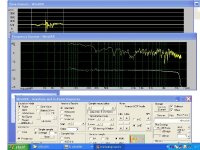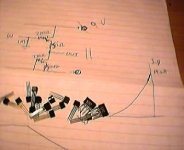Grey,
Interesting commentary regards fleshing out the crossover buzz word.
It might help if someone illustrated these issues with a simple box design example so those who are miffed by all this Xovia and all its spots can sleep without taking those meds prescribed by Mr Pass.
Perhaps to round out the discussion the correct use of loudspeaker measuring software may also prove useful .
I recall prior to building my 1st monitor a few years ago I would stay up late reading the crossover chapter in Vance Dickasons "'The Loudspeaker Cookbook" over and over trying to work through all the options.(chapter 7 4th edition).
The irony of this was that after working out all the passive network values based on what I thought was right I was quite amazed at the roller coast response measurement on a friends IMP measuring system.
My friend (Doug Tipping..founder of the local Tech College Loudspeaker Course) then proceeded to adjust some of the values in the network... significantly. I was a bit taken back by this and recall commenting that hey it won't be 3rd order anymore..rant ...rant ..rant.
Well about 1/2 an hour later after plugging in a few different values we had a graph within +-3 db over 100 - 20 kherts.
This was a real education, not only the on practical aspects of crossover design but also some tips on how measure a loudspeaker and interpret the results.... Needless to say after some more minor tweaks the system sounded Fab( a 4 way system I might add).
Trust me I'm no expert but persistence pays dividends. (and I don't trust me own ears!
Here is a link to a great site on simple measurements that won't break the bank.......enjoy.
http://pcbunn.cithep.caltech.edu/jjb/WinAIRR/WinAIRR.html
Attached is a screen dump of the Winairr system for those interested.
macka
Interesting commentary regards fleshing out the crossover buzz word.
It might help if someone illustrated these issues with a simple box design example so those who are miffed by all this Xovia and all its spots can sleep without taking those meds prescribed by Mr Pass.
Perhaps to round out the discussion the correct use of loudspeaker measuring software may also prove useful .
I recall prior to building my 1st monitor a few years ago I would stay up late reading the crossover chapter in Vance Dickasons "'The Loudspeaker Cookbook" over and over trying to work through all the options.(chapter 7 4th edition).
The irony of this was that after working out all the passive network values based on what I thought was right I was quite amazed at the roller coast response measurement on a friends IMP measuring system.
My friend (Doug Tipping..founder of the local Tech College Loudspeaker Course) then proceeded to adjust some of the values in the network... significantly. I was a bit taken back by this and recall commenting that hey it won't be 3rd order anymore..rant ...rant ..rant.
Well about 1/2 an hour later after plugging in a few different values we had a graph within +-3 db over 100 - 20 kherts.
This was a real education, not only the on practical aspects of crossover design but also some tips on how measure a loudspeaker and interpret the results.... Needless to say after some more minor tweaks the system sounded Fab( a 4 way system I might add).
Trust me I'm no expert but persistence pays dividends. (and I don't trust me own ears!
Here is a link to a great site on simple measurements that won't break the bank.......enjoy.
http://pcbunn.cithep.caltech.edu/jjb/WinAIRR/WinAIRR.html
Attached is a screen dump of the Winairr system for those interested.
macka
Attachments
Both of you are spot on.
I recall the revelatory crossover design that the head of ESS
was ecstatic over until the frequency response curve was
measured, and we saw that it had no midrange. None.
Well, he was as human as the rest of us, and had the
personal courage to have a good laugh.
Beranek's Law is apropos, but any intelligent designer still likes
the equipment to measure decently. Beranek is also assuming
that you have the equipment to make the measurements.
We can also examine the anti-Beranek view: that if the stuff
measures well, the builder will hear wonderful sound regardless
of the quality of the parts or crappiness of an enclosure, etc.
I've experienced that, too.
I recall the revelatory crossover design that the head of ESS
was ecstatic over until the frequency response curve was
measured, and we saw that it had no midrange. None.
Well, he was as human as the rest of us, and had the
personal courage to have a good laugh.
Beranek's Law is apropos, but any intelligent designer still likes
the equipment to measure decently. Beranek is also assuming
that you have the equipment to make the measurements.
We can also examine the anti-Beranek view: that if the stuff
measures well, the builder will hear wonderful sound regardless
of the quality of the parts or crappiness of an enclosure, etc.
I've experienced that, too.

I forgot to mention the Winairr software is available from AudioExpress, here is the link:
http://www.audioxpress.com/download/index.htm
The cost of a demo is $5.00.
Essentially all you need is a PC with a full duplex sound card and a suitable microphone. (See the link for details.) and a length of shielded rca cable to run between the mic & PC and PC and amp.
I used the Panasonic insert like the one used in the Mitey mic and mounted it in the end of a length of aluminium tube. This feeds a simple mic preamp and then into the line input of your soundcard.
The Panasonic insert is sufficiently flat in response that it will satisfy the majority of 1st time diy audio measurement needs.
A few pillows and a duna for damping floor reflections etc and you are ready to start.
macka
http://www.audioxpress.com/download/index.htm
The cost of a demo is $5.00.
Essentially all you need is a PC with a full duplex sound card and a suitable microphone. (See the link for details.) and a length of shielded rca cable to run between the mic & PC and PC and amp.
I used the Panasonic insert like the one used in the Mitey mic and mounted it in the end of a length of aluminium tube. This feeds a simple mic preamp and then into the line input of your soundcard.
The Panasonic insert is sufficiently flat in response that it will satisfy the majority of 1st time diy audio measurement needs.
A few pillows and a duna for damping floor reflections etc and you are ready to start.
macka
This post is in the spirit of the true diy audio.
It nags me that we strive for simplicity and minimal parts count with just two gain stages or less in our amplifiers, and here we are adding stages for an active crossovers virtues.
Good Lord, God of Zen please forgive we audio mortals.
Amen,
That said and with my new bread board, a handful of Jfets, Mosfets, Bjts and the Pass Diy Opamp & Borbely articles handy I am ready to experiment with my own simple opamps and followers.
Plan A is the set up the various circuits from the articles, study their characteristics and insert them in the signal path for audition (with unity gain).
Plan B is to add the SK crossover topology to the opamps and followers with time constants outside the audio spectrum and again insert the circuits in the signal path for audition.
While not an entirely scientific study, I think it will be an interesting experiment to see whether I hear more or less with these simple stages in the signal path.
I will report on the findings in due course.
macka

It nags me that we strive for simplicity and minimal parts count with just two gain stages or less in our amplifiers, and here we are adding stages for an active crossovers virtues.
Good Lord, God of Zen please forgive we audio mortals.
Amen,
That said and with my new bread board, a handful of Jfets, Mosfets, Bjts and the Pass Diy Opamp & Borbely articles handy I am ready to experiment with my own simple opamps and followers.
Plan A is the set up the various circuits from the articles, study their characteristics and insert them in the signal path for audition (with unity gain).
Plan B is to add the SK crossover topology to the opamps and followers with time constants outside the audio spectrum and again insert the circuits in the signal path for audition.
While not an entirely scientific study, I think it will be an interesting experiment to see whether I hear more or less with these simple stages in the signal path.
I will report on the findings in due course.
macka

Attachments
- Status
- Not open for further replies.

